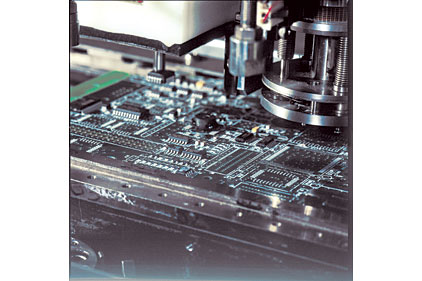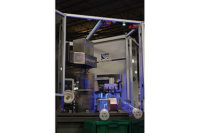Synchronization is the process of coordinating individual actions of members in a group working in unison, following a common timeline, toward a common group goal. Repeatability and predictability are keys to synchronization.
In an orchestra, each musician knows how high his or her pitch or tone must be at each instant in time during the rendition. Lack of synchronization will lead to an imperfect rendition.
“In the same way, each component of an assembly machine should know and be able to do what it is supposed to do at each instant,” says Nishant Unnikrishnan, a motion application engineer at Yaskawa America Inc. “A lag in positioning will make an imperfect part.”
An example of synchronization would be a pin insertion machine based on an X-Y gantry system. If the X and Y axes are not synchronized to the master axis, the pin that needs to be inserted will not get inserted at the correct location. Accuracy and repeatability are also a priority for glue-dispensing machines, pick-and-place mechanisms, vision systems, fluid dispensers and robotic manipulators.
Synchronization technology has changed over the last decade. With the introduction of digital electronics in manufacturing, a shift from the use of mechanical components to mechatronic components has occurred.
Bulky, mechanically driven components like gears and cams, which were traditionally used for synchronized motion, have been replaced by compact, quieter servo-driven actuators. There is no physical contact required between components to ensure synchronization. “This has improved machine characteristics like throughput and productivity, and made assembly machines quieter,” says Unnikrishnan.
Synchronization is important in high-speed assembly applications, because of the quality of the assembled part. “If the assembly operations of a machine are not synchronized, the part being assembled will be imperfect,” explains Unnikrishnan.
Synchronization also speeds up a process. “All operations that can be carried out simultaneously can be carried out at the same time if synchronized motion is used,” says Unnikrishnan. “The number of steps in a multistep process can be reduced if there are operations that are carried out simultaneously and in a synchronized fashion. This reduces cycle time.”
High-speed synchronized motion can be achieved with a multi-axis motion controller that can perform calculations quickly, a high-speed deterministic motion network, and servos with fast processing speeds and response characteristics.
“An assembly machine should be able to communicate with [upstream and downstream] stations,” Unnikrishnan points out. “Therefore, fast and reliable communication protocols that enable plantwide communications are a necessity in any high-speed assembly process.”
Motion controller features that enable synchronized motion are mainly electronic camming and electronic gearing. The ability to synchronize either position or velocity is important for multi-axis synchronization in assembly processes.
Flexibility in camming and gearing tools—such as changing scales, offsets and shifts, or changing gear ratios on the fly while the machine is in operation—are features that greatly reduce downtime and set up time for machines.
The ability to use virtual axes, compensate for communication delays and apply filters to ensure smooth motion are some other features that will help a machine run at high speeds without compromising on product quality.
In synchronized motion, each slave axis’ motion is dependent on a master axis. The master axis could be time, an encoder wheel or a virtual axis.
According to Unnikrishnan, the biggest mistake engineers make is not understanding the various components that contribute to a synchronous machine.
“Although main motion is actuated by servos, there are mechanical components that perform auxiliary motion in any machine,” he explains. “These mechanical components may have a different (usually slower) response time than servos. Such slower components can act as a bottleneck in machine operation. Identifying critical components that need to be synchronized and that need to run fast is a key step that engineers may miss.”



